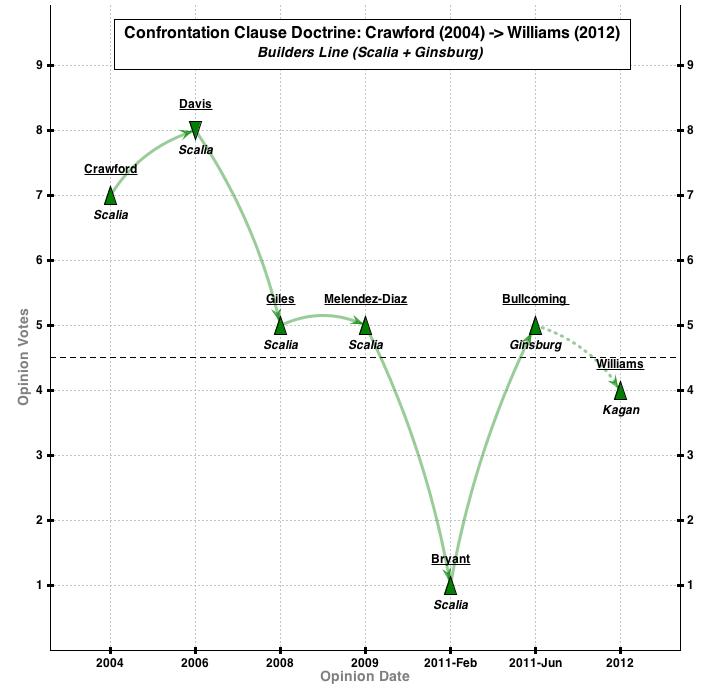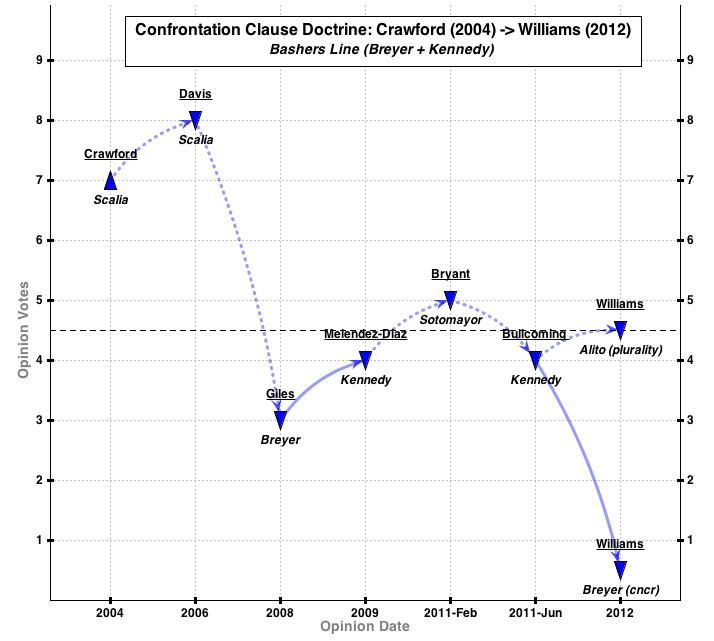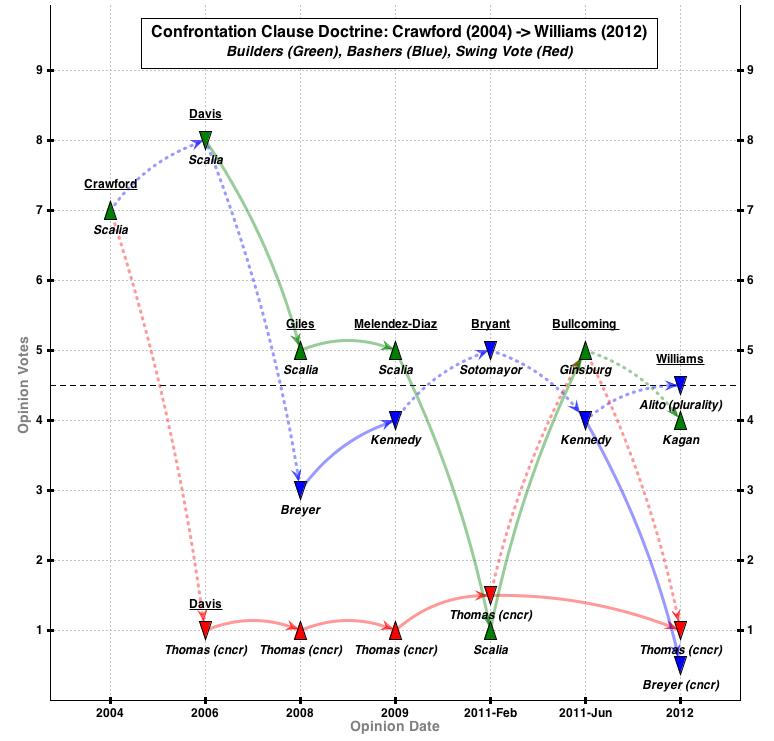This is the fifth and final installment in a series mapping Confrontation Clause doctrine since Crawford v. Washington (2004). In previous posts, I identified the 2-degree network connecting Williams v. Illinois (2012) to Crawford, calibrated the network to correct over- and under-inclusiveness issues, analyzed the network’s degree of dissent, and disaggregated the network into its 23 constituent opinions. Today I’ll wrap up by charting out the primary competing lines in the doctrine. I identify three major lines, which I’ll call the Builders, the Bashers, and the Swing Vote.
The story here begins in 2004. Five of the justices currently sitting on the Court participated in the original Crawford deliberations — Scalia, Kennedy, Thomas, Ginsburg, and Breyer. Those five justices remain the prime movers in the Confrontation Clause debate today. Although all five signed on to Justice Scalia’s majority opinion in Crawford, they have since split into three camps. Let’s examine each camp in turn.
First up we have the Builders line. I call Justices Scalia and Ginsburg by this name because they have sought to build up and extend Crawford‘s innovation. While Scalia is clearly the doctrine’s main architect, Ginsburg has proved a staunch ally. Scalia and Ginsburg have written every majority opinion where the right was vindicated and they were the only two justices to dissent in Bryant. Indeed, the Builders’ perspective has shone though in every case except Williams. ( Of course, both Scalia and Ginsburg signed onto Kagan’s Williams dissent.)
Before turning to the Bashers line, a brief explanation about map legend is in order. All of today’s maps use upward-facing triangles to represent opinions advocating in favor of the confrontation right/criminal defendant and downward facing triangles to represent the opposite. Solid arrows connecting opinions to each other signify connection between the main justices/authors in the line. Dotted arrows represent connections with less central justices/authors. Thus, the arrow from Bullcoming to Williams in the map above is dotted since Kagan — not main Builders Scalia or Ginsburg — wrote that dissent.
Though it was not always so, Kennedy and Breyer are the Bashers of Crawford doctrine. At first, the Bashers joined Scalia — shown in the map by the dotted lines from Crawford and Davis. Then came Giles. And then came the split. (For an excellent discussion about Giles‘ doctrinal impact, see Prof. Richard Friedman’s contribution to the this recent Michigan Law Review Symposium). After Giles, Kennedy and Breyer have bashed the confrontation right in every case the Court has heard. Thus, the Bashers are the doctrinal nemeses of the Builders.
 Finally, there is Thomas. He is the Swing Vote. Amazingly, Thomas is the only justice to have voted with the majority in every single case in this line. He picks the winners. And Thomas’ campaign to affect the doctrine actually started before the Bashers split in Giles. Thomas first voiced his unique formal approach to understanding what makes a statement “testimonial” in Davis. And in every case after Davis (except for Bullcoming), Thomas has doggedly pushed his perspective. For his persistent efforts, Thomas can claim success. Though Thomas only concurred in Williams, at least one court reckons his is the controlling opinion.
Finally, there is Thomas. He is the Swing Vote. Amazingly, Thomas is the only justice to have voted with the majority in every single case in this line. He picks the winners. And Thomas’ campaign to affect the doctrine actually started before the Bashers split in Giles. Thomas first voiced his unique formal approach to understanding what makes a statement “testimonial” in Davis. And in every case after Davis (except for Bullcoming), Thomas has doggedly pushed his perspective. For his persistent efforts, Thomas can claim success. Though Thomas only concurred in Williams, at least one court reckons his is the controlling opinion.
The map above brings the Builders, Bashers, and Swing Vote into a single frame. This image represents the major doctrinal currents at play in Confrontation Clause jurisprudence. These are the waters to be navigated by advocates in Ohio v. Clark, the Court’s next major Crawford-line case.
This post is already longer than usual; it’s time to sign off. Before doing so, I want to make a final point. Though the map above distills what I see as the most important lines in the debate, I recognize that it is incomplete. If I had time — alas, winter break is here and grades are due soon! — I might also trace the complications introduced by the post-2004 justices. (The Kagan-Sotomayor line is interesting, for example, since they both voted with the Bashers in Bryant but joined the Builders in Bullcoming and Williams.) Perhaps adding to this map will be a project for this Blog in 2015.
Until then, Happy Holidays!



